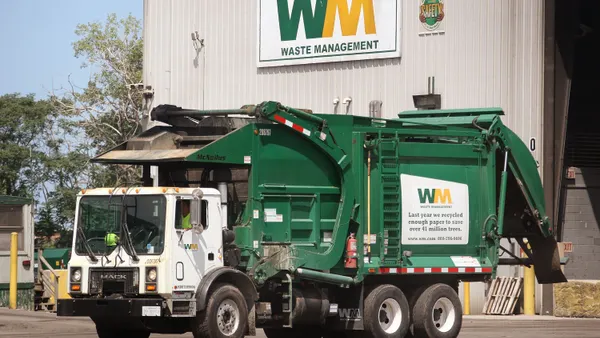Dive Brief:
- A new report from labor and environmental coalition Transform Don't Trash says that an estimated 3,300 new jobs could be created in New York if the city's combined residential and commercial recycling rate was increased to 70%. The baseline is a 21% average diversion rate (not including construction and demolition waste.)
- Citing research from the Northeast Recycling Council and the Illinois Recycling Council, the report says that cities with higher diversion rates have 60% more recycling and processing jobs per ton of waste than New York. A 2011 study by the Tellus Institute that showed more jobs are created by recycling and composting operations than landfills or waste-to-energy facilities was used to calculate possible job creation.
- The potential siting of new material recovery facilities, anaerobic digesters or other organics processing facilities is seen as one of the largest areas for job creation. Electronics repair, textile collection, food recovery for donation and furniture refurbishment were also highlighted.
Dive Insight:
This report covers the potential jobs created from increasing diversion rates for both residential and commercial waste, though TDT's main mission is to push forward on the creation of a commercial waste franchise system. The recent approval of a similar system in Los Angeles, which includes a multitude of requirements on infrastructure investment and recycling programs for a range of materials, is a key model.
“We want to see the city design the new commercial zone system so it will really incentivize the kinds of investment we’re seeing in Los Angeles," report co-author Justin Wood told Waste Dive.
While some recent projects such as the Sims Municipal Recycling facility in Brooklyn have been well-received by the local community, the appetite for any type of waste-related facility in the city is still very low. Retrofitting existing infrastructure, such as wastewater treatment plants, to handle some of this material has also been a slow process as seen with the city's anaerobic digestion pilot at Newtown Creek. Refurbishment and repair operations could be an easier sell in one of the city's industrial areas, but they won't necessarily yield the same volume of jobs as these larger facilities.
“Siting major industrial recyclers in and near the city is not necessarily a realistic policy option," said Wood. “Our point here is not that everything needs to be within the five boroughs, but that we can create really strong regional jobs."
In a recent report, the EPA said that recycling and related activities were responsible for 757,000 jobs which created an estimated $36.6 billion in wages and $6.7 in tax revenue in 2007. The details of collection costs, emissions and commodity prices will of course make this more complicated on a local level. Though the potential to create jobs in the metropolitan region while increasing diversion may be one of the rare things that everyone involved in the commercial waste debate can agree on.











